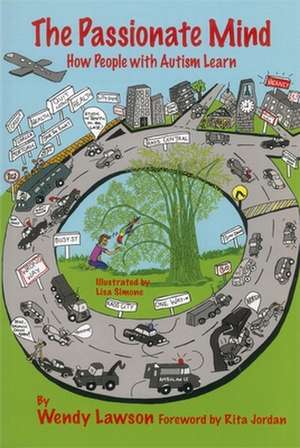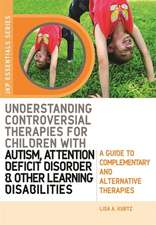The Passionate Mind: How People with Autism Learn
Autor Wendy Lawsonen Limba Engleză Paperback – 31 aug 2010
Preț: 127.18 lei
Preț vechi: 162.14 lei
-22% Nou
Puncte Express: 191
Preț estimativ în valută:
24.34€ • 25.41$ • 20.14£
24.34€ • 25.41$ • 20.14£
Carte disponibilă
Livrare economică 14-28 martie
Livrare express 27 februarie-05 martie pentru 49.78 lei
Preluare comenzi: 021 569.72.76
Specificații
ISBN-13: 9781849051217
ISBN-10: 1849051216
Pagini: 224
Dimensiuni: 150 x 228 x 18 mm
Greutate: 0.33 kg
Editura: Jessica Kingsley Publishers Ltd
Locul publicării:United Kingdom
ISBN-10: 1849051216
Pagini: 224
Dimensiuni: 150 x 228 x 18 mm
Greutate: 0.33 kg
Editura: Jessica Kingsley Publishers Ltd
Locul publicării:United Kingdom
Notă biografică
Wendy Lawson, a psychologist, lecturer and author, has operated her own private practice for many years. Wendy was awarded fourth place as 'Victorian Australian of the year' in 2008. Originally diagnosed as being intellectually disabled, then in her teens as being schizophrenic, finally Wendy was diagnosed as being on the autism spectrum in 1994. The mother of four children, Wendy has been married, separated and divorced, has experienced the death of one of her teenage sons, lost friends and status due to being openly gay, faced ill health and recently is coming to terms with the fact that she is aging! Wendy's youngest son is also on the autism spectrum.
Cuprins
Acknowledgements. Foreword by Professor Rita Jordan. 1.Introduction. The reasons for writing this book. The power of words. Brain configuration. What to expect in this text. The role of attention and interest. 2. The Autism Spectrum: Where we are we now?. Introduction. What does autism spectrum look like? Gender. Autism spectrum strengths. Learning style. Sensory differences. 3. Cognitive theories of autism spectrum. Introduction. Cognition and cognitive theory. Considering theory in autism spectrum. Attention and interest. 4. Cognitive theory: Theory of mind. Introduction. Definition. Foundations for theory of mind. Components of theory of mind. Application to child development. Development of theory of mind. Difficulties with a rigid view of theory of mind development. The most noted test of theory of mind. Theory of mind research over time. Questions concerning theory of mind theory. Other potential questions. Summary. 5. Cognitive theory: Executive functioning. Introduction. Definition. Foundations for executive functioning. Components of executive functioning. Application to child development. Development of executive functioning. Research over time. Executive functioning and theory of mind. Questions concerning executive functioning and the autism spectrum. Other questions and limitations. Summary. 6. Cognitive theory: Weak central coherence. Introduction. Definition. Foundations for weak central coherence theory . Components of weak central coherence theory. Application in the neurotypical and autism spectrum population. Research over time. Limitations of weak central coherence theory. Summary. 7. Cognitive theory: Enhanced perceptual functioning. Introduction. Definition. Foundations for enhanced perceptual functioning theory. Components of enhanced perceptual functioning. Research over time. Comparison with other cognitive theories. Limitations of enhanced perceptual functioning theory. Summary. 8. An alternative cognitive theory: single attention and associated cognition in autism. Introduction. Definitions. Monotropism as a foundation for SAACA. Attention. Attention and Brain Configuration. Monotropism and the sensory system. Monotropism and interest. Attention, motivation and interest. Triad of impairments or product of monotropic attention? Processing style. Monotropism and learning style. Complex cognitive skills coupled with interest and attention. Cognitive components of SAACA. Monotropism and literality. Monotropism and thinking in closed concepts. Monotropism: context and scale. Monotropism: timing, sequencing and predicting. Monotropism and non social priorities. Summary. 9. The relevance of SAACA. Introduction. Everyday experiences for autism spectrum individuals. When things change. The concept of time. SAACA's explanation of why autism spectrum and neurotypical perception are different. Case studies. Autism spectrum comprehension. Problems with autism spectrum comprehension. (if using a neurotypical lens). What might it mean when an expectation is not fulfilled? Problem solving ideas using SAACA. Tom's story - An extended case study. Why does Tom have difficulties? Can we help Tom cope with change? When and how do we execute an intervention for Tom? What about generalising Tom's learning? Reasoning behind using IT, visuals and structure. Neurotypical parenting. Summary. 10. Looking to the future. A different learning style. Completing tasks. Normality. It's in everyone's interest. Experiments to refute or support SAACA. Limitations of SAACA. List of publications. References. Appendix A. Appendix B. Appendix C. Appendix D. Appendix E. Index.













